The 10 Most Disgusting Delicacies to Try Before You Die - Would You Eat These?

“Think” Fear Factor and Iron Chef combined and you have THE potentially most disgusting buffet of expertly prepared food delicacies on the planet. The world is truly a diverse place especially when you launch a gustatory exploration of what have become curious ick-factor foods for a modernized, watered-down, American palate. Truth is as “foreign” as most of these dishes can be, many have deep cultural underpinnings, some of them the side dishes of famous feasts and the tables of kings.
All the vital organs of just about any species have been consumed at one time or another and some of them are rich in the best dietary nutrients. Amazonian ants, half-cooked fetal eggs, wriggly worms of all kinds and stages of life, hoofs, beaks, ears, and eyeballs have all been efficiently put to good culinary use. Prep methods are just as enticing: fermenting, pickling, infusing, boiling, blowtorching, decomposing, and simply served live and wriggling.
Culinary Thrill-Seeking for Some, Time-Honored Traditions for Others
If you’re a gag-seeker, foodie adventurer, or looking for some tantalizing new ethnic dish to serve to guests that goes well beyond the ordinary dinner party fare, here are some of the notoriously “I hope I’m never served…” foods, and how they’re prepared, from around the globe.
1. This Cheese is So Gross It’s Been Outlawed…
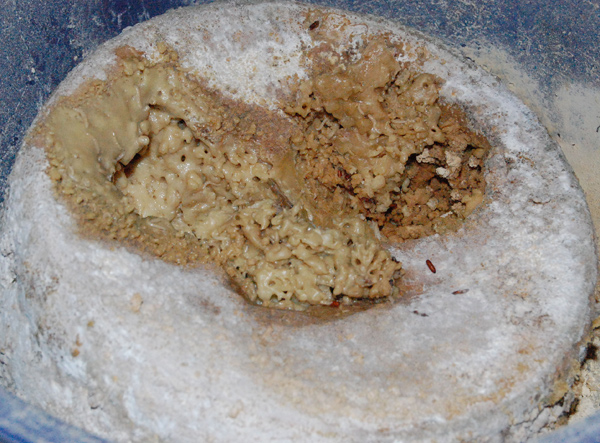
Casu Marzu, a pecorino cheese and Sardinian specialty, surely wins among most disgusting cheeses of the world. The direct translation is “rotten cheese” and rightly so: blocks of otherwise beautiful Italian pecorino cheeses are purposely prepared to become the natural breeding grounds for nests of maggots—the natural harbingers of rot and putrefaction. As if pecorino wasn’t pungent enough…
Like many distinct ethnic practices and traditions, formaggio marcio, is a generations old culinary delicacy, with roots in familial history. The process of producing casu marzu, aka “maggot cheese,” is considered a process of finely metered fermentation. However regionally traditional the consumption of maggot-laced cheese, it hardly jives with modern food preparation and sanitation mores, therefore the offending cheese is officially illegal. Don’t let that stop you from searching for a chunk along your Italian travels, even if it will run you a steep number of Euros and from a “black market” peddler. “Godfather, you want formaggio marcio? We’ll get you formaggio marcio, don’t you worry.” Reports are it tastes exactly as you might imagine: strong pecorino, the crawly snot-plump bodies of insect larvae, and the slimy fat they’ve made of the digested cheese. Oh, and the worms jump off the cheese while you’re eating it. Mange!
2. Mongolian Boodog

They don’t call it “Outer Mongolia” for nothing. Nomads, sans stainless steel gourmet kitchens, ages ago found more ingenious ways to cook a whole goat, sometimes marmot (but they may have fleas that host bubonic plague, so goat may be a better choice)—from the inside out, after you’ve hung it upside down, bled it and broken its legs. The stuffing is a bit non-Western, too: smooth hot stones crammed into every cavity imaginable and even up under the leg skin where you would have yanked the broken the bones out. Blowtorch the beast ‘til desired doneness; it can also be roasted over an open fire. That’s authentic Mongolian barbecued meat, Boodog.
3. Soft-Boiled Fetal Duck
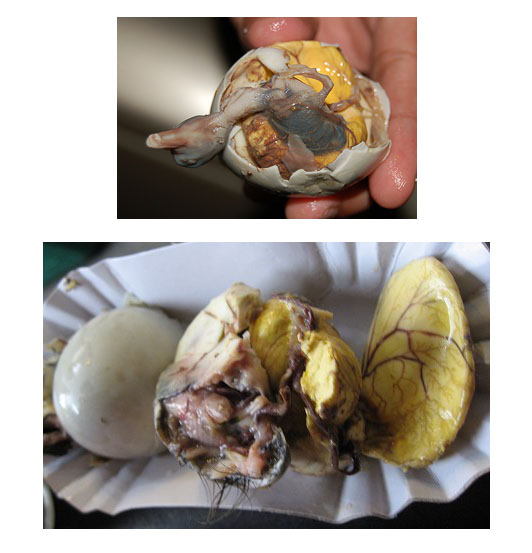
Balut takes a top spot by a landslide among the gross egg category, which should include 100-year old eggs. Balut is a fairly common and unassuming street food available in both the Philipines and Vietnam. It has also earned a widespread reputation as one of the all-time grossest ethnic delicacies. Most of the eggs with which Americans are familiar are unfertilized eggs. The balut, though are fertilized duck eggs, incubated or allowed to grow invitro for a certain length of time, usually a few weeks. Peel back the shell and along with a typical soft-boiled eggy interior is also the small inert body of a fetal duck—small bones, feathers, beak and all, some more developed than others. Most accounts suggest slurping it right from the shell with a pinch of salt. There is a right way to “enjoy” balut.
4. Whole Sheep’s Head
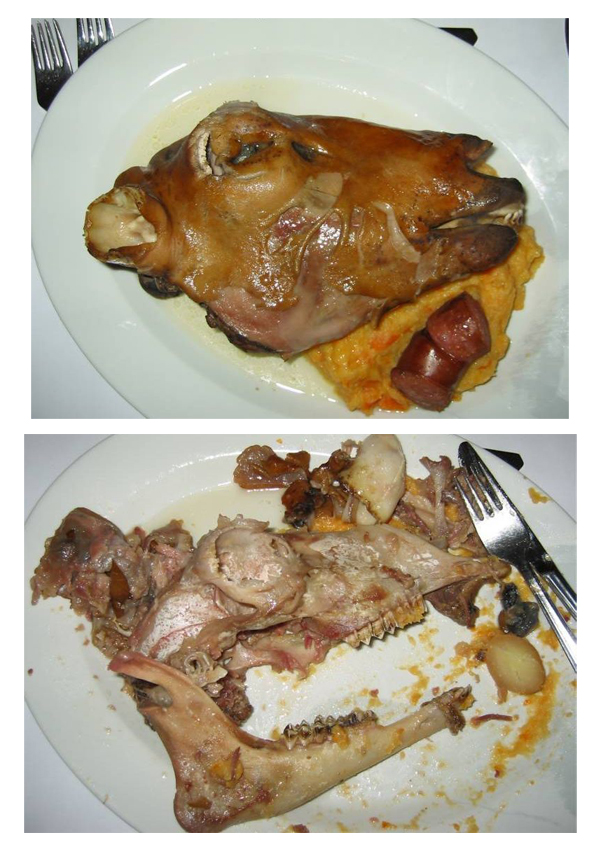
Sheep’s head has been a traditional delicacy served in a number of world regions, including the Mediterranean and Northern Europe. You’ll find smoked versions and recipes for sheep’s head soup, usually presented whole and intact, sometimes with brains, often without (risky to consume). The eyeballs and tongue are particular delicacies. In America, most meats are separated from their heads, their feet, their tails—so we can forget about the fact that we’re eating something that once had a head, feet and a tail and at that point we no longer call it cow or pig, but T-bone steak, and bacon. Herein lies the grisly factor in sitting down to a meal of whole sheep’s head.
5. Octopus, Straight-Up
Anything still alive and squirming is food for a “most disgusting” list. Raw seafood is legendary in most Asian cuisines. Japanese sushi is notorious in the raw realms. Raw octopus is common as is still alive octopus, served straight-up on a plate or in a bowl. Baby octopus (sannakji) may be served cut into bite-sized, still-wriggling pieces, suction cups and all, or slurped squirming, whole. Octopus is exactly as you might imagine: rubbery, chewy and fairly tasteless and some brave adventurers report the suction cups sticking on the way down. Regardless, the dish has been a valued part of Korea’s cuisine for centuries and is considered a vitality enhancer and a health food. At the other end of the spectrum, Korean kimchi is often fermented in jars underground for months and may use brined seafood for seasoning.
6. Vacationing in Alaska: “Don’t Eat the Stink Heads”
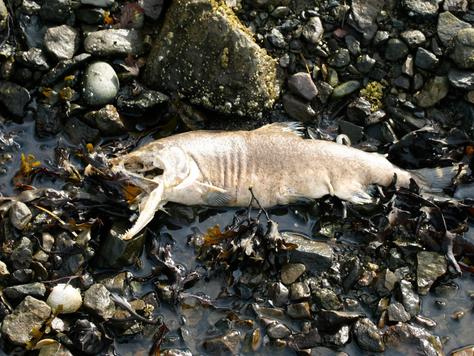
Salmon is a staple of the native Alaskan diet and natives have traditionally used all parts of the fish. One of the traditional delicacies is fermented salmon heads. Colloquially the dish has earned the name “stink heads.” Essentially the heads of King salmon are buried in the ground in fermentation pits, put into plastic or wooden barrels, even plastic food storage bags, and left to let nature do its thing for a few weeks or more. The heads are then harvested and consumed as a putty-ish mash.
“Stink heads” as a distinct ethnic cuisine have been covered in various mainstream media the latest of which is The Food Network’s “Bizarre Foods” show. In and of themselves salmon heads are not repulsive, whole fish dishes are a legitimate part of rustic AND haute cuisine everywhere and King salmon is a real world delicacy. What has struck the “gross-out” nerve is the overriding fact that much of the stink head prep process is less about fermentation and more about rot and decomposition. The dish, by modern culinary standards, is nothing but rotten salmon heads, albeit treasured tribal fare. Imagine, a bucket load of large King Salmon heads left outside during the warm summer months for a few weeks….Outside the native Alaskan culture the stink head topic is nothing but a novelty, but health-wise the tradition of stink head consumption poses a real and continued challenge to regional Alaskan healthcare professionals faced with frequent and, sometimes serious, totally avoidable botulism cases.
7. Deadly Fish: License to Cook
One of Japan’s most elite delicacies is also one of the most dangerous dishes you’d ever put in your mouth. The fugu fish is a cute little puffer fish, hardly “most disgusting,” but grossly lethal, certainly. Coursing throughout its vital fish organs is deadly venom—tetrodotoxin-- a natural defense system that renders its attackers paralyzed. Ingest enough of this fish’s poison and you’ll go belly-up, too dying a slow death from conscious paralysis and asphyxia. Currently, no type of anti-venom exists to undo what’s done from fugu poisoning. Regardless of the risk, in Japan’s most luxurious restaurants trained and licensed fugu chefs deftly prepare fugu for high society types, fugu aficionados, and culinary thrill seekers. Chefs adhere to strict preparation, sanitation, storage, and disposal guidelines to minimize risk.
Has fugu killed anyone? You bet it has, though annual deaths resulting from fugu consumption nowadays are few and generally accidental. For true gastronomic satisfaction the best chefs are able to prepare fugu laced with a remaining trace of venom, which reportedly tingles on the tongue, providing the eater with a sensory brush with death. The potential risk makes fugu even more a thrill to consume and one forbidden to hit the Japanese Emporer’s dinner plate.
8. Jellied Moose Nose
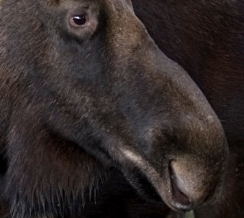
The ‘jelly’ part makes it sound sweet, like a clear jelly you spread on a nice thick slice of toasted sourdough. But jellied is how the moose nose is prepared, not jelly as in bread spread. This is, after all the cooking is done, a traditional and time-honored Alaskan dish of real sliced moose snout. White meat or dark?
The list could go on AND even more interestingly be drawn from the perspective of someone well outside the American diet. A non-American list of most disgusting “delicacies” would probably begin with the All-American hotdog and a bag of pork rinds: “A ghastly, but clever disguising of cast off animal parts that do nothing for your health or virility.”
9. Bat Paste – Make sure you try this last because it could kill you.
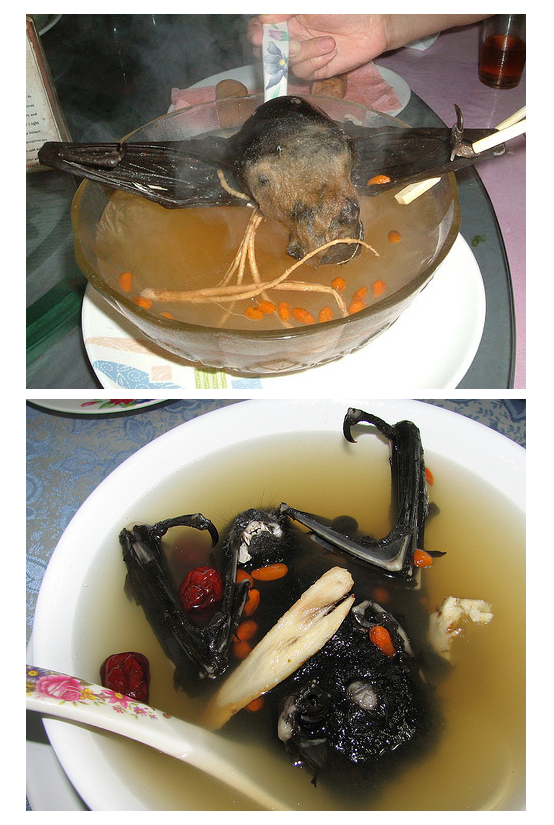
First, net a bunch of flying mouse, fruit, or fox bats in a remote village.
Drop live into a pot of boiling water or milk.
Roast to desired doneness.
Chop and make into paste with Thai herbs and spices.
Or when you have an abundance of fruit bats, try this optional Fruit Bat Soup recipe.
Bats are part of the native cuisine in Thailand, parts of China, Guam and more, but they are considered notorious disease carriers. You might want to consider dropping them to the bottom of your culinary To-Try list.
10. Your Turn? Want to Win $500?
We wanted to make sure we listed the most disgusting delicacies, but the world is a big place, and so we need your help. If you have seen or heard of a dish that you think is the most disgusting meal in the world please share it with us. We will list the finalists on March 23rd for public vote on our blog. The winner will receive $500.
Please submit the dish name, a link to an image of the dish, a description of the dish, and your email address. Thanks for your help in competing this article!
Update: finalists selected...please vote now!
Best of luck with the contest, and thanks for participating! Contest void where prohibited by law.
Culinary Training
Top Schools
- Culinary Arts Schools
- Le Cordon Bleu
- The Art Institutes
- Kitchen Academy
- Johnson and Wales
- French Culinary Institute
- New England Culinary Institute
Majors
- Culinary Majors
- Culinary Arts
- Baking & Pastry Arts
- Food Prep/Prof. Cooking
- Hotel & Restaurant Management
- Culinary Arts Management
- Wine, Spirits & Beverage Management
